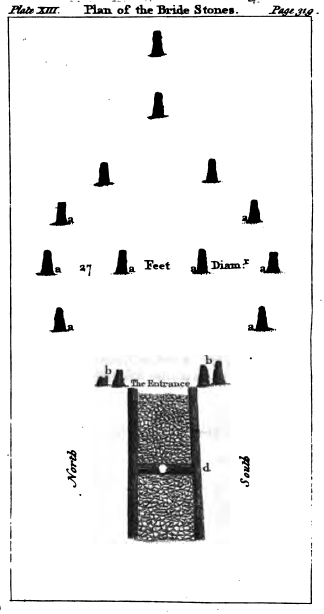The Bridestones on:
[Wikipedia]
[Google]
[Amazon]
The Bridestones is a chambered cairn, near Congleton, Cheshire, England, that was constructed in the

Neolithic
The Neolithic period, or New Stone Age, is an Old World archaeological period and the final division of the Stone Age. It saw the Neolithic Revolution, a wide-ranging set of developments that appear to have arisen independently in several p ...
period about 3500–2400 BC. It was described in 1764 as being long and wide, containing three separate compartments, of which only one remains today. The remaining compartment is long by wide, and consists of vertical stone slabs, divided by a now-broken cross slab. The cairn originally had a stone circle surrounding it, with four portal stones; two of these portal stones still remain. The site is protected as a scheduled ancient monument
In the United Kingdom, a scheduled monument is a nationally important archaeological site or historic building, given protection against unauthorised change.
The various pieces of legislation that legally protect heritage assets from damage and d ...
.
Condition in 18th century
The state of the site was recorded in the second edition of Henry Rowlands's ''Mona Antiqua Restaurata'' (published in 1766), based on a report by Rev. Thomas Malbon, rector of Congleton. As the report describes removal of stones for road-building in 1764 (the Ashbourne–Leek–Congleton Turnpike, now Dial Lane, just south of the site), it appears that it was included by Henry Owen, editor of the second edition, and was not part of Rowlands's original 1723 edition. The report provides a detailed description of the site at the time along with a plate giving a plan of the site.
Folklore and naming
The origin of the cairn's name is unclear. One legend says that a recently married couple were murdered at the location, and the stones were laid around their grave. Another possibility is that they are named after Brigantia. Alternatively, theOld English
Old English (, ), or Anglo-Saxon, is the earliest recorded form of the English language, spoken in England and southern and eastern Scotland in the early Middle Ages. It was brought to Great Britain by Anglo-Saxon settlers in the mid-5th c ...
word for "birds" was "briddes"; the stones in their original form could have resembled birds, giving rise to "Briddes stones".
Subsequent destruction
The largest single ransacking of the monument was the removal of several hundred tons to construct the nearby turnpike road. Stones from the monument were also taken to build the nearby house and farm; other stones were used in an ornamental garden inTunstall Park
Victoria Park is a public park in Tunstall, in Stoke-on-Trent, Staffordshire, England. It is owned and operated by Stoke-on-Trent City Council. Few significant changes have been made since the early 20th century; it is listed Grade II in Histori ...
. The holed stone was broken some time before 1854; the top half was found replaced in 1877 but was gone again by 1935.
While the southern side of the main chamber was originally a single, , it was split in 1843 by a picknicker's bonfire. Of the portal stones, only two remain, one of which is broken and concreted back together. This was reputedly caused by an engineer from the Manchester Ship Canal, who used the stone to demonstrate a detonator.
Excavations of the site were done by Professor Fleur of Manchester University
, mottoeng = Knowledge, Wisdom, Humanity
, established = 2004 – University of Manchester Predecessor institutions: 1956 – UMIST (as university college; university 1994) 1904 – Victoria University of Manchester 1880 – Victoria Univer ...
in 1936 and 1937, with the aim of restoring the site as much as possible to its former condition.
See also
* Scheduled Monuments in Cheshire (pre-1066)References
Sources
* * * * *External links
* {{DEFAULTSORT:Bridestones The Stone Age sites in England Megalithic monuments in England Buildings and structures in Cheshire Archaeological sites in Cheshire History of Cheshire Tourist attractions in Cheshire Scheduled monuments in Cheshire